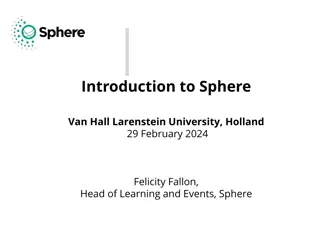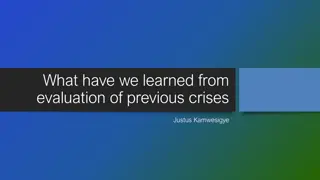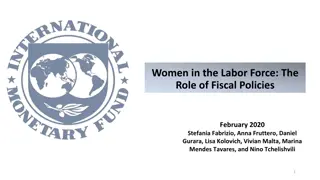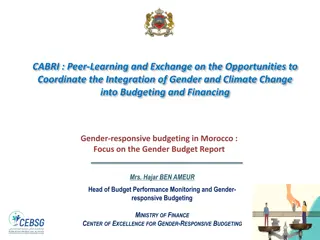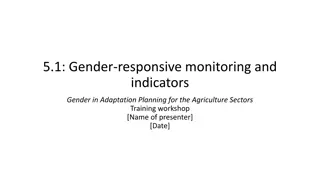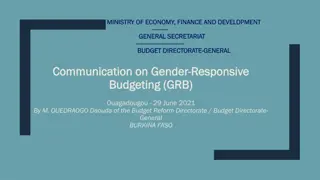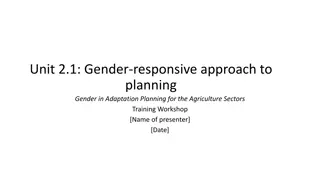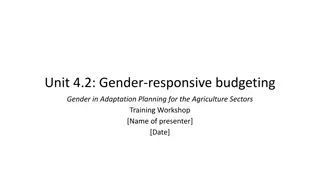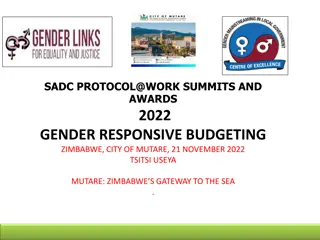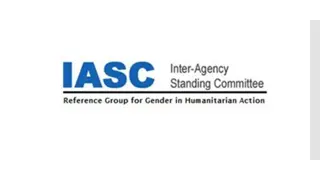Gender-Responsive Humanitarian Leadership and Transformation
Challenges in implementing gender-responsive humanitarian programmes require greater political will, leadership, resources, accountability, and capacity building. Feminist leadership aims to transform power dynamics, fight inequality, and create inclusive structures. It involves principles, values, politics, purpose, and challenging existing power structures in order to promote gender equality in humanitarian actions.
Download Presentation

Please find below an Image/Link to download the presentation.
The content on the website is provided AS IS for your information and personal use only. It may not be sold, licensed, or shared on other websites without obtaining consent from the author.If you encounter any issues during the download, it is possible that the publisher has removed the file from their server.
You are allowed to download the files provided on this website for personal or commercial use, subject to the condition that they are used lawfully. All files are the property of their respective owners.
The content on the website is provided AS IS for your information and personal use only. It may not be sold, licensed, or shared on other websites without obtaining consent from the author.
E N D
Presentation Transcript
Slide 1 Humanitarian Programme Cycle Source: UN OCHA, Visual Information Unit
Slide 2 Challenges in implementing gender-responsive humanitarian programmes Policies and strategies abound. The gap is translating them into action. We need greater political will, leadership, resources, accountability and capacity building. As well as investment in gender equality before, during and after crises. In short, the institutionalization of gender in humanitarian action.
Slide 3 Feminist Leadership for Social Transformation Standard notion of leadership: Individual decision maker and provider of vision; authority over others; typically male Feminine leadership: collaboration, collective decision making, relationship-building (always true?) Feminist leadership: deals with power and politics; transforms relations of power and fights inequality; creates alternative models of power with their own inclusive, non-oppressive structures and processes
Slide 4 The feminist leadership diamond Politics andPurpose Power Principles and Practices Values Source: Based on image in S. Batliwala (2011). Feminist Leadership for Social Transformation: Clearing the Conceptual Cloud. New Delhi:CREA.
Slide 5 Leadership as power To challenge visible, hidden and invisible power, especially where (in deep structures ) it creates and reinforces women s subordination, or furthers discrimination against women. To create alternative models of power that increase the visible form, and gradually eliminate invisible and hidden power
Slide 6 Leadership as principles and values Values and principles inform our leadership. Feminist values: equality, inclusion, the rights of all people, freedom from violence. In disaster and conflict situations they risk being compromised. Need clear principles to inform strategic choices during precarious times.
Slide 7 Leadership as politics and purpose Politics: The analysis of the socio-economic realities and the ideological lens that informs that analysis (e.g. profit, social justice). Starts with gender and social analysis. Purpose: The vision and mission for change that emerges from our politics. Leadership development must enable us to articulate our politics and purpose clearly.
Slide 8 Leadership as practice Ways of working which fall into seven categories: visioning; political; strategic; relationships; communication; resourcing; managerial. Building leadership skills in these seven areas needs to be done in a way which connects these practices to power, politics andvalues.
Slide 9 How can we begin to practice feminist leadership? Step 1 Analysing power in our organizations and uncovering the deep structures . Step 2 Examining and articulating our politics and purpose. Step 3 Clarifying the principles and values that guide our practice. Step4 Designing our practice to harmonize better withthe other Ps . Step 5 Checking our self and taking responsibility for how we operate.
Slide 10 The feminist leadership diamond Source: Oxfam leadership model
Slide 11 Oxfam s leadership model elements Four components: power, values, purpose and practices The Self (attributes, talents, experiences each leader brings) surrounds the four quadrants and influences their implementation Need to value and respect the unique leadership identity that each leader brings to the role Need to create an enabling environment forother leaders to emerge and thrive Leadership must respond to local context Shared leadership: individual leadership comes to life through purposeful and enabling relationship with others with teams, coalitions and alliances who share a common purpose
Slide 12 Srilatha Batliwala: Feminist Leadership for Social Transformation (p 74) For every great feminist leader we can think of from anywhere in the world, past and present has one thing in common: she led by challenging and disturbing the status quo. What does this say to you? Can you think of anyone who fits this description of a feminist leader?
Slide 13 Influencing and handling conflict Thomas-Kilmann theory: All five strategies areuseful. Deciding which to use depends on the relative importance of the issue/goal versus the relationship. The win-win solution is usually collaboration. Competition Collaboration importance of issue Compromise Avoidance Accommodation importance ofrelationship Source: Image design based on the Thomas-Kilmann theory of strategies of handling conflict.


